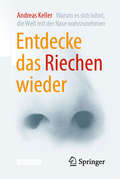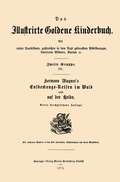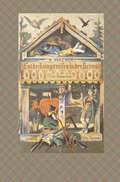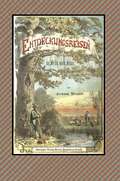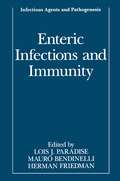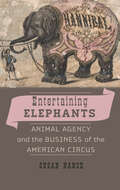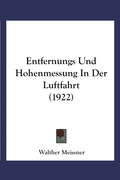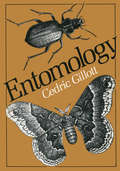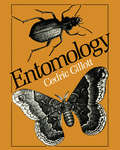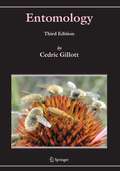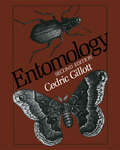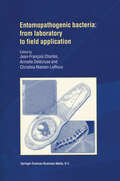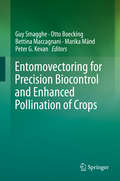- Table View
- List View
Entanglement Measures and Their Properties in Quantum Field Theory (SpringerBriefs in Mathematical Physics #34)
by Stefan Hollands Ko SandersThis book gives a rigorous treatment of entanglement measures in the general context of quantum field theory. It covers a broad range of models and the use of fields allows us to properly take the localization of systems into account. The required mathematical techniques are introduced in a self-contained way.
Entdecke das Riechen wieder: Warum Es Sich Lohnt, Die Welt Mit Der Nase Wahrzunehmen
by Andreas KellerWarum es sich lohnt, die Welt mit der Nase wahrzunehmenEntdecke das Riechen wieder riecht wie alle anderen Bücher, aber nachdem Sie es gelesen haben, werden Bücher und vieles andere für Sie nicht mehr so riechen wie zuvor. Ob es bei Menschen Pheromone gibt, warum es so schwierig ist, über Gerüche zu reden, welches Tier den besten Riecher hat und warum manche Menschen den Geruch von Spargel-Urin nicht riechen können - das sind nur einige der Fragen, die der Geruchsforscher Andreas Keller in diesem Buch beantwortet. Menschen besitzen eine gute Nase, haben aber im Laufe der Evolution mehr und mehr verlernt, sie zu benutzen. Dieses Buch wird Sie überzeugen, dass Riechen nicht so mysteriös ist, wie oft angenommen, und dass es sich lohnt, die Welt wieder (auch) mit der Nase wahrzunehmen. In einem Zeitalter, das von digitalisierten Erfahrungen geprägt ist, die beliebig kopiert und für die Ewigkeit gespeichert werden können, bedeutet die flüchtige Realität eines Geruches mehr als je zuvor.
Entdeckungen in Arabien (Arbeitsgemeinschaft für Forschung des Landes Nordrhein-Westfalen #30)
by Werner CaskelEnteric Infections and Immunity (Infectious Agents and Pathogenesis)
by Lois J. Paradise Mauro Bendinelli Herman FriedmanAs we approach the end of this millennium, enteric diseases remain impor tant public health problems. In many parts of the world, sanitary measures have advanced little over the last century, although some of the governments in those areas are striving to improve facilities for sanitation and to educate their people in proper handling of food, water, sewage, and other modes of transmission of pathogenic microbes. Even in highly developed countries, outbreaks of diarrheal diseases occur today. Globally, the annual morbidity from enteric infections is estimated at several billion and deaths at several million per year. In this volume, descriptions of some of these diseases, of immunity that results from them, of clinical studies that promote under standing of individual and community immunity, of molecular factors of pathogenesis, and/or of advances in vaccine development have been pro vided by leading researchers. At present, the application of molecular methods is enhancing the identification of protective antigens of many microorganisms. In addition, new methods for design and delivery of vac cines are being devised. Perhaps then more effective tools for reducing at least some of these diseases will be available within the next decade. Lois J. Paradise Herman Friedman Mauro Bendinelli vii Contents Introduction . . . . . . . . . . . . . . . . . . . . . . . . . . . . . . . . . . . . . . . . . . . . xv LOIS J. PARADISE 1. Indigenous Microorganisms as a Host Defense 1 KENNETH H. WILSON 1. Introduction . . . . . . . . . . . . . . . . . . . . . . . . . . . . . . . . . . . . . . . . 1 2. Composition of Intestinal Biota. . . . . . . . . . . . . . . . . . . . . . . . 2 3. Molecular Approaches to Determine Composition of the Biota . . . . . . . . . . . . . . . . . . . . . . . . . . . . . . . . . . . . . . . . . . . 3 4. Role of the Host in Determining the Composition of the Biota . . . . . . . . . . . . . . . . . . . . . . . . . . . . . . . . . . . . . . . . . . .
The Enteric Nervous System II (Advances in Experimental Medicine and Biology #1383)
by Nick J. Spencer Marcello Costa Stuart M. BrierleyThis book is based on the proceedings of the Enteric Nervous System conference in Adelaide, Australia, under the auspices of the International Federation for Neurogastroenterology and Motility. The book focuses on methodological strategies and unresolved issues in the field and explores where the future is heading and what technological advances have been made to address current and future questions. The Enteric Nervous System II continues in the tradition of a popular earlier volume which covered the previous meeting. Many of the same authors are contributing to this new volume, presenting state-of-the-art updates on the many developments in the field since the earlier meeting. The coverage include a wide range of topics, from structure and function of the enteric nervous system through gut motility and visceral pain. The author team includes long-established authorities who significantly contributed to the advances in ENS research over the past two decades and the new generation that will continue to contribute to advancing our understanding of the field.
Enterprise 2.0: Unternehmen zwischen Hierarchie und Selbstorganisation
by Jörg Eberspächer Stefan HoltelEnterprise Interoperability: I-ESA'12 Proceedings
by Martin Zelm Raquel Sanchis Guy Doumeingts Raúl PolerIn a fast changing world governed by innovative Enterprise Services and the Future Internet, the issue of Enterprise Interoperability is no longer limited to the interoperation of systems within a single company, but has become a much greater multi-view issue of interoperability throughout a Network of Enterprises. This book contains the proceedings of 13 workshops presented as short papers and discussions held at each workshop. The workshops were co-located with the I-ESA’12 Conference organized by the Polytechnic University of Valencia, Spain. Complementary to the conference program, the workshops aimed at exploiting new issues, challenges and solutions for Enterprise Interoperability. The scope of the workshops spanned a wide range of interoperability issues in Service Science and Innovation, Model Driven Interoperability, Service Oriented Architectures, Factories of the Future, Enterprise Networks and Management, SME Aspects and Standards.
Enterprise Interoperability: I-ESA'12 Proceedings (Lecture Notes In Business Information Processing Ser. #122)
by Martin Zelm Raquel Sanchis Raul Poler Guy DoumeingtsIn a fast changing world governed by innovative Enterprise Services and the Future Internet, the issue of Enterprise Interoperability is no longer limited to the interoperation of systems within a single company, but has become a much greater multi-view issue of interoperability throughout a Network of Enterprises. This book contains the proceedings of 13 workshops presented as short papers and discussions held at each workshop. The workshops were co-located with the I-ESA’12 Conference organized by the Polytechnic University of Valencia, Spain. Complementary to the conference program, the workshops aimed at exploiting new issues, challenges and solutions for Enterprise Interoperability. The scope of the workshops spanned a wide range of interoperability issues in Service Science and Innovation, Model Driven Interoperability, Service Oriented Architectures, Factories of the Future, Enterprise Networks and Management, SME Aspects and Standards.
Enterprises’ Green Growth Model and Value Chain Reconstruction: Theory and Method
by Nengmin Wang Qi Jiang Bin Jiang Zhengwen HeThe goal of this book is to improve the ability of enterprises to implement the green growth model and value chain reconstruction. China’s environmental development strategies, such as carbon peak emission and carbon neutrality, have created new challenges and requirements for enterprises to “go green.” In addition, anti-globalization and the complex dynamic uncertainty caused by COVID-19 have changed the operational environment that enterprises face. The application of new technologies, including the new generation of information technologies and the whole process management technology, provides solutions for the implementation of enterprises’ green growth model and value chain reconstruction. Based on China’s enterprise management cases, this book reveals the connotative features of enterprises’ green growth model and their evolutionary regularities, the overall framework and decision optimization of value chain reconstruction under the green growth model, and the approach to implementing the green growth model and value chain reconstruction. The theoretical framework of the green growth model and value chain reconstruction established in this book has enriched and developed the research results in this field. Cases of enterprises implementing the green growth model can provide references for the green transformation of enterprises and help enterprises appreciate the synergy between sustainability and growth. This book can also serve as a research reference for scholars engaged in the field of sustainable operations, as well as decision-makers and managers of relevant government departments.
Entertaining Elephants: Animal Agency and the Business of the American Circus (Animals, History, Culture)
by Susan NanceConsider the career of an enduring if controversial icon of American entertainment: the genial circus elephant. In Entertaining Elephants Susan Nance examines elephant behavior—drawing on the scientific literature of animal cognition, learning, and communications—to offer a study of elephants as actors (rather than objects) in American circus entertainment between 1800 and 1940. By developing a deeper understanding of animal behavior, Nance asserts, we can more fully explain the common history of all species.Entertaining Elephants is the first account that uses research on animal welfare, health, and cognition to interpret the historical record, examining how both circus people and elephants struggled behind the scenes to meet the profit necessities of the entertainment business. The book does not claim that elephants understood, endorsed, or resisted the world of show business as a human cultural or business practice, but it does speak of elephants rejecting the conditions of their experience. They lived in a kind of parallel reality in the circus, one that was defined by their interactions with people, other elephants, horses, bull hooks, hay, and the weather. Nance’s study informs and complicates contemporary debates over human interactions with animals in entertainment and beyond, questioning the idea of human control over animals and people's claims to speak for them. As sentient beings, these elephants exercised agency, but they had no way of understanding the human cultures that created their captivity, and they obviously had no claim on (human) social and political power. They often lived lives of apparent desperation.
Entertaining Elephants: Animal Agency and the Business of the American Circus (Animals, History, Culture)
by Susan NanceConsider the career of an enduring if controversial icon of American entertainment: the genial circus elephant. In Entertaining Elephants Susan Nance examines elephant behavior—drawing on the scientific literature of animal cognition, learning, and communications—to offer a study of elephants as actors (rather than objects) in American circus entertainment between 1800 and 1940. By developing a deeper understanding of animal behavior, Nance asserts, we can more fully explain the common history of all species.Entertaining Elephants is the first account that uses research on animal welfare, health, and cognition to interpret the historical record, examining how both circus people and elephants struggled behind the scenes to meet the profit necessities of the entertainment business. The book does not claim that elephants understood, endorsed, or resisted the world of show business as a human cultural or business practice, but it does speak of elephants rejecting the conditions of their experience. They lived in a kind of parallel reality in the circus, one that was defined by their interactions with people, other elephants, horses, bull hooks, hay, and the weather. Nance’s study informs and complicates contemporary debates over human interactions with animals in entertainment and beyond, questioning the idea of human control over animals and people's claims to speak for them. As sentient beings, these elephants exercised agency, but they had no way of understanding the human cultures that created their captivity, and they obviously had no claim on (human) social and political power. They often lived lives of apparent desperation.
An Entertainment for Angels: Electricity in the Enlightenment (Icon Science)
by Patricia FaraElectricity was the scientific fashion of the Enlightenment, 'an Entertainment for Angels, rather than for Men'. Lecturers attracted huge audiences to marvel at sparkling fountains, flaming drinks, pirouetting dancers and electrified boys. Enlightenment optimists predicted that this new-found power of nature would cure illnesses, improve crop production, even bring the dead back to life. Benjamin Franklin, better known as one of America's founding fathers, played a key role in developing the new instruments and theories of electricity during the eighteenth century. Celebrated for drawing lightning down from the sky with a kite, Franklin was an Enlightenment expert on electricity, developing one of the most successful explanations of this mysterious phenomenon. But Patricia Fara, Senior Tutor of Clare College Cambridge, reveals how the study of electricity became intertwined with Enlightenment politics. By demonstrating their control of the natural world, Enlightenment philosophers hoped to gain authority over society. And their stunning electrical performances provided dramatic evidence of their special powers.
Entfernungs- und Höhenmessung in der Luftfahrt
by Walther MeißnerDieser Buchtitel ist Teil des Digitalisierungsprojekts Springer Book Archives mit Publikationen, die seit den Anfängen des Verlags von 1842 erschienen sind. Der Verlag stellt mit diesem Archiv Quellen für die historische wie auch die disziplingeschichtliche Forschung zur Verfügung, die jeweils im historischen Kontext betrachtet werden müssen. Dieser Titel erschien in der Zeit vor 1945 und wird daher in seiner zeittypischen politisch-ideologischen Ausrichtung vom Verlag nicht beworben.
The Entolomataceae of Tasmania (Fungal Diversity Research Series #22)
by machiel noordeloos Genevieve M. GatesThis book is the result of 14 years of collecting Entolomataceae in the native forests of Tasmania, Australia. Although initially involving only the Tasmanian residents Genevieve Gates and David Ratkowsky, who made twice- or thrice-weekly forays into the forests throughout the year, the project was subsequently joined by agaric specialist Machiel Noordeloos from the Netherlands, and by fungi photographer Michael Pilkington from the United Kingdom.The international character of the project is further evidenced by the earlier contributions of American mycologist Tim Baroni to the Tasmanian Rhodocybe species which form the basis of the chapter on the now-expanded concept of Clitopilus, and a visit of several months in 2010 by Brazilian Ph.D. candidate Fernanda Karstedt, who tested the keys to the Entoloma species. Consequently, several thousand well-annotated collections were found during this inventory and form the basis of this monographic treatment of the Entoloma and Clitopilus of Tasmania.The resulting 90 Entoloma species and 10 Clitopilus species are well documented with standardized descriptions, line drawings of fruit bodies and diagnostic microscopic characters, and, when available, with colour photographs. Thanks to the intensive search, it was possible to illustrate most species in colour. Dichotomous keys facilitate identification of the species. The species concept used is morphologically based; in several cases, however, identification to species level is supported by molecular data.
Entomology
by Cedric GillotThe idea of writing this book was conceived when, in the late 1960s, I began teaching a senior undergraduate class in general entomology. I soon realized that there was no suitable text for the class I intended to give. The so-called "general" or "introductory" texts reflected the traditional taxonomic approach to entomology and contained relatively little information on the physiology and ecology of insects. This does not mean that there were no books containing such information. There were several, but these were so specialized and de tailed that their use in an introductory class was limited. I hold a strong belief that an undergraduate general entomology course should provide a balanced treatment of the subject. Thus, although some time should be devoted to taxonomy, including identification (best done in the laboratory, using primar ily material which students themselves have collected, supplemented with specimens from the general collection), appropriate time should be given also to discussion of the evolution, development, physiology, and ecology of in sects. In the latter category I include the interactions between insects and Man because it is important to stress that these interactions follow normal ecological principles. Naturally, the format of this book reflects this belief. The book has been arranged in four sections, each of which necessarily overlaps with the others.
Entomology
by Cedric GillottThe idea of writing this book was conceived when, in the late 1960s, I began teaching a senior undergraduate class in general entomology. I soon realized that there was no suitable text for the class I intended to give. The so-called "general" or "introductory" texts reflected the traditional taxonomic approach to entomology and contained relatively little information on the physiology and ecology of insects. This does not mean that there were no books containing such information. There were several, but these were so specialized and de tailed that their use in an introductory class was limited. I hold a strong belief that an undergraduate general entomology course should provide a balanced treatment of the subject. Thus, although some time should be devoted to taxonomy, including identification (best done in the laboratory, using primar ily material which students themselves have collected, supplemented with specimens from the general collection), appropriate time should be given also to discussion of the evolution, development, physiology, and ecology of in sects. In the latter category I include the interactions between insects and Man because it is important to stress that these interactions follow normal ecological principles. Naturally, the format of this book reflects this belief. The book has been arranged in four sections, each of which necessarily overlaps with the others.
Entomology
by Cedric GillottGillott’s thorough yet clear writing style continues to keep Entomology near the top of the class as a text for senior undergraduates, and for graduate students and professionals seeking an introduction to specific entomological topics. The author’s long-held belief that an introductory entomology course should present a balanced treatment of the subject is reflected in the continued arrangement of the book in four sections: Evolution and Diversity, Anatomy and Physiology, Reproduction and Development, and Ecology. For the third edition, all chapters have been updated. This includes not only the addition of new information and concepts but also the reduction or exclusion of material no longer considered "mainstream", so as to keep the book at a reasonable size. Based on exciting discoveries made during the previous decade, the topics of insect evolutionary relationships, semiochemicals, gas exchange, immune responses (including those of parasites and parasitoids), flight, and the management of pests have received particular attention in the preparation of the third edition. Overall, more than 30 new or significantly revised figures have been incorporated.
Entomology
by Cedric GillottExtensively revised, the Second Edition continues to offer senior undergraduate students a well-balanced treatment of all major areas in entomology. This edition features coverage of the new phylogenies for most of the insect orders
Entomopathogenic Bacteria: from Laboratory to Field Application
by J. F. Charles Armelle Delécluse C. Nielsen-Le RouxEntomopathogenic bacteria (Bacillus thuringiensis and B. sphaericus) are increasingly used as biopesticides to control larval insect populations which are either agricultural or forestry pests and to reduce those which as adults are vectors of severe human diseases. This new book, the first since 1993 to address all aspects of entomopathogenic bacteria, provides undergraduate and graduate students as well as research scientists with a complete, modern view of this important group of bacteria. The authors, chosen for their sustained contributions to the field, cover both fundamental and applied research in this area. The main topics include bacterial ecology and taxonomy, toxin diversity, activity and mode of action, regulation and environment of the genes, safety and ecotoxicology, production and field application of the bacteria, and outbreaks of resistant populations. The book concludes with the most recent data obtained on transgenic biotechnology and addresses environmental impact issues.
Entomopathogenic Nematodes and Their Symbiotic Bacteria: A Laboratory Manual (Springer Protocols Handbooks)
by S. Sivaramakrishnan M. RaziaThis book provides basic information and different protocols associated with the Entomopathogenic nematodes (EPNs) and their symbiotic bacteria. Entomopathogenic nematodes (EPNs) of the genera Steinernema and Heterorhabditis and their associated bacterial symbionts Xenorhabdus and Photorhabdus aid nematode infective juveniles (IJs) in infecting and killing their insect hosts, creating a unique tripartite complex of host-vector-symbiont interactions. Due to this insect killing capability, EPNs are used as biological control agents of economically important insect pests. They are also a model system to study host-parasite interactions.It provides a systematic approach to various nematode procedures including pathogenicity, reproduction, foraging behaviour. It gives a brief outline on historical aspects, nematode-bacterium complex, biology and chemical ecology of EPNs. It concisely describes host insect rearing, nematode sampling and storage, isolation techniques, counting, handling and staining of nematodes, characterization including morphological, molecular and ecological studies, mass production, virulence bioassay, field application and efficacy. The book also includes methods and techniques for their associated symbiotic bacteria.This book serves as a laboratory manual and assists the readers to undertake advanced research in different aspects related to nematodes. It is useful for researchers in the fields of nematology, microbiology, bacteriology and entomology.
Entomovectoring for Precision Biocontrol and Enhanced Pollination of Crops
by Guy Smagghe Otto Boecking Bettina Maccagnani Marika Mänd Peter G. KevanThis book focuses on entomovectoring, also known as apivectoring, the method used for managing pollinators to increase crop yields and employ strategies of biocontrol in greenhouses and open fields. It is written by experts working in academia and industry from the different continents of the world. Over the past 25 years Research and Development has successfully investigated the potential of pollinators to perform two tasks: dispersal of biological control agents (BCOs) and their pollination service. This book provides a basic overview of the current literature on the different aspects and factors of this novel technology. It explains and presents practical cases of enhancing pollination coupled with the suppression of plant pathogens and pests under various agricultural production practices from greenhouse to open field conditions and crops ranging from orchard fruits, to small and tender berries, vegetables and oil seeds

